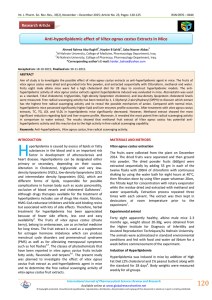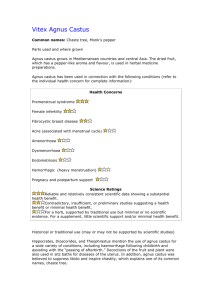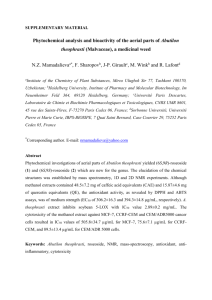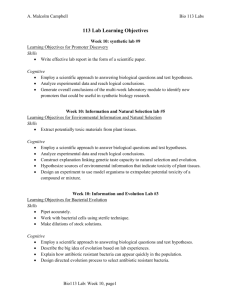Document 13310172
advertisement
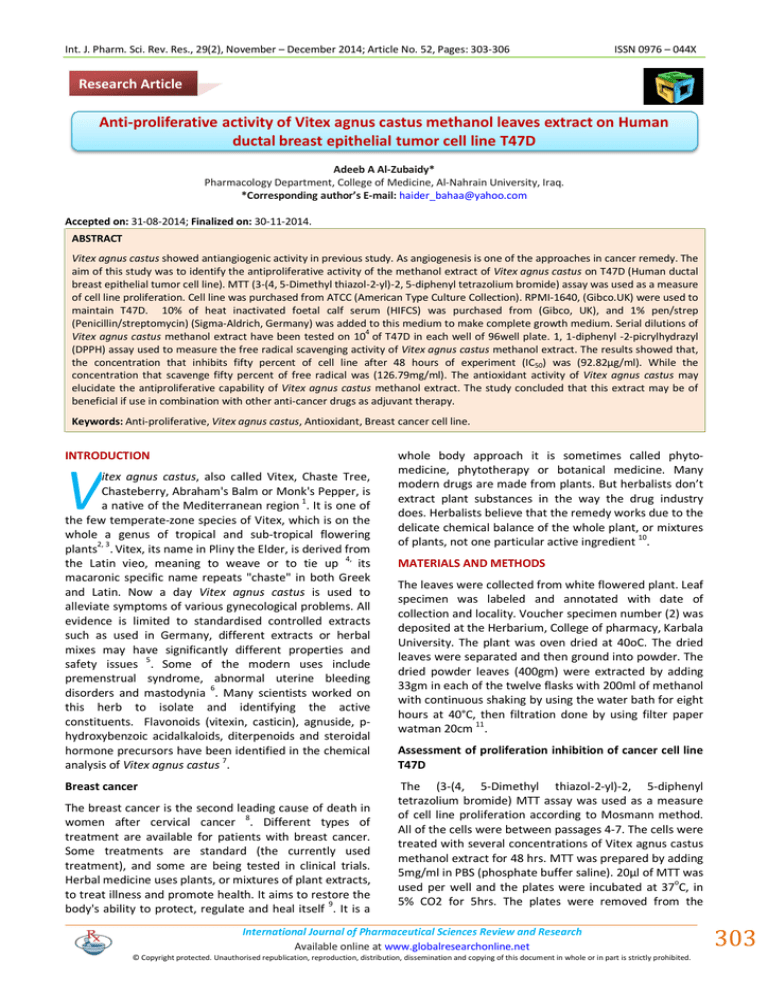
Int. J. Pharm. Sci. Rev. Res., 29(2), November – December 2014; Article No. 52, Pages: 303-306 ISSN 0976 – 044X Research Article Anti-proliferative activity of Vitex agnus castus methanol leaves extract on Human ductal breast epithelial tumor cell line T47D Adeeb A Al-Zubaidy* Pharmacology Department, College of Medicine, Al-Nahrain University, Iraq. *Corresponding author’s E-mail: haider_bahaa@yahoo.com Accepted on: 31-08-2014; Finalized on: 30-11-2014. ABSTRACT Vitex agnus castus showed antiangiogenic activity in previous study. As angiogenesis is one of the approaches in cancer remedy. The aim of this study was to identify the antiproliferative activity of the methanol extract of Vitex agnus castus on T47D (Human ductal breast epithelial tumor cell line). MTT (3-(4, 5-Dimethyl thiazol-2-yl)-2, 5-diphenyl tetrazolium bromide) assay was used as a measure of cell line proliferation. Cell line was purchased from ATCC (American Type Culture Collection). RPMI-1640, (Gibco.UK) were used to maintain T47D. 10% of heat inactivated foetal calf serum (HIFCS) was purchased from (Gibco, UK), and 1% pen/strep (Penicillin/streptomycin) (Sigma-Aldrich, Germany) was added to this medium to make complete growth medium. Serial dilutions of 4 Vitex agnus castus methanol extract have been tested on 10 of T47D in each well of 96well plate. 1, 1-diphenyl -2-picrylhydrazyl (DPPH) assay used to measure the free radical scavenging activity of Vitex agnus castus methanol extract. The results showed that, the concentration that inhibits fifty percent of cell line after 48 hours of experiment (IC50) was (92.82µg/ml). While the concentration that scavenge fifty percent of free radical was (126.79mg/ml). The antioxidant activity of Vitex agnus castus may elucidate the antiproliferative capability of Vitex agnus castus methanol extract. The study concluded that this extract may be of beneficial if use in combination with other anti-cancer drugs as adjuvant therapy. Keywords: Anti-proliferative, Vitex agnus castus, Antioxidant, Breast cancer cell line. INTRODUCTION V itex agnus castus, also called Vitex, Chaste Tree, Chasteberry, Abraham's Balm or Monk's Pepper, is a native of the Mediterranean region 1. It is one of the few temperate-zone species of Vitex, which is on the whole a genus of tropical and sub-tropical flowering plants2, 3. Vitex, its name in Pliny the Elder, is derived from the Latin vieo, meaning to weave or to tie up 4, its macaronic specific name repeats "chaste" in both Greek and Latin. Now a day Vitex agnus castus is used to alleviate symptoms of various gynecological problems. All evidence is limited to standardised controlled extracts such as used in Germany, different extracts or herbal mixes may have significantly different properties and safety issues 5. Some of the modern uses include premenstrual syndrome, abnormal uterine bleeding disorders and mastodynia 6. Many scientists worked on this herb to isolate and identifying the active constituents. Flavonoids (vitexin, casticin), agnuside, phydroxybenzoic acidalkaloids, diterpenoids and steroidal hormone precursors have been identified in the chemical analysis of Vitex agnus castus 7. Breast cancer The breast cancer is the second leading cause of death in women after cervical cancer 8. Different types of treatment are available for patients with breast cancer. Some treatments are standard (the currently used treatment), and some are being tested in clinical trials. Herbal medicine uses plants, or mixtures of plant extracts, to treat illness and promote health. It aims to restore the body's ability to protect, regulate and heal itself 9. It is a whole body approach it is sometimes called phytomedicine, phytotherapy or botanical medicine. Many modern drugs are made from plants. But herbalists don’t extract plant substances in the way the drug industry does. Herbalists believe that the remedy works due to the delicate chemical balance of the whole plant, or mixtures of plants, not one particular active ingredient 10. MATERIALS AND METHODS The leaves were collected from white flowered plant. Leaf specimen was labeled and annotated with date of collection and locality. Voucher specimen number (2) was deposited at the Herbarium, College of pharmacy, Karbala University. The plant was oven dried at 40οC. The dried leaves were separated and then ground into powder. The dried powder leaves (400gm) were extracted by adding 33gm in each of the twelve flasks with 200ml of methanol with continuous shaking by using the water bath for eight hours at 40°C, then filtration done by using filter paper 11 watman 20cm . Assessment of proliferation inhibition of cancer cell line T47D The (3-(4, 5-Dimethyl thiazol-2-yl)-2, 5-diphenyl tetrazolium bromide) MTT assay was used as a measure of cell line proliferation according to Mosmann method. All of the cells were between passages 4-7. The cells were treated with several concentrations of Vitex agnus castus methanol extract for 48 hrs. MTT was prepared by adding 5mg/ml in PBS (phosphate buffer saline). 20µl of MTT was used per well and the plates were incubated at 37οC, in 5% CO2 for 5hrs. The plates were removed from the International Journal of Pharmaceutical Sciences Review and Research Available online at www.globalresearchonline.net © Copyright protected. Unauthorised republication, reproduction, distribution, dissemination and copying of this document in whole or in part is strictly prohibited. 303 Int. J. Pharm. Sci. Rev. Res., 29(2), November – December 2014; Article No. 52, Pages: 303-306 incubator and the supernatant was aspirated. DMSO (200µl) was added to each well. The plates were shaken vigorously for one minute at room temperature to dissolve the dark blue crystals. The absorbance reading was taken at 570nm and the reference at 650nm by using micro-plate reader. The absorbance of cells cultured in control media was taken to represent 100% viability. The viability of treated cells was determined as a percentage of that for the untreated control. Each concentration was tested in quadruplicate, and the experiment was repeated twice. The concentration of the cells in each well was 1x104, the percentage of cell line inhibition was determined as the mean ± SD, using the following equation. ISSN 0976 – 044X Vitex agnus castus, was calculated by using the following linear regression equation below: Y=0.5064(X) + 3.02, where Y= the percentage of inhibition and X= concentration. The IC50 value for ME was 92.82µg/ml. Figures 1 shows the dose response curve. 1-(A0-A1)/ (A2-A1) Figure 1: Dose response curve of Vitex agnus castus methanol extract on T47D A0 = Absorbance of sample A1 = Absorbance of blank DPPH Assay for Vitex agnus castus methanol extract A2 = Absorbance of control IC50 values were calculated by the linear equation 12. 1, 1-diphenyl -2-picrylhydrazyl (DPPH) free radical scavenging activity The free radical scavenging activity of the Vitex agnus castus methanol extract was measured by DPPH methods. One ml of 0.1 mM solution of DPPH in methanol was added to 2ml Vitex agnus castus methanol extracts with the following concentrations (0.5, 0.25, 0.12, 0.062, 0.031, 0.015, and 0.007mg/ml); after 30min, absorbance was measured at 517nm. All concentrations of Vitex agnus castus extract were tested in triplicate. Percentage reduction of DPPH (Q) was calculated according to the formula below 13. Figure 2 shows the dose response curve of methanol extract of Vitex agnus castus on DPPH scavenging activity. The data is represented as mean ± SD. Serial dilution of the concentrations ranged of 0.5, 0.25, 0.125, 0.0625, 0.03125, 0.0156 and 0.0078mg/ml was used throughout. Methanol was used as a solvent, each concentration was triplicate, IC50 of the DPPH scavenging activity, of ME, was calculated by the linear regression equation. Q=100 × (A0-AC)/ A0 Where A0= Absorbance of control AC=Absorbance of the two samples after 30 min incubation. Figure 2: The dose response curve of serial dilutions of Vitex agnus castus methanol leaves extract on DPPH free radical scavenging activity RESULTS Activity of Vitex agnus castus methanol leaves extracts on T47D breast cancer cell line In vitro screening of Vitex agnus castus methanol extract on T47D hormonal dependant breast cancer cell line, which were in passage 7 the results showed a dosedependent inhibition on the cell growth after 48hr. The extract concentrations used were 200, 100, 50, 25, 12.5 and 6.25µg/ml, with each concentration in quadruplicate and the experiments were repeated twice. The data is represented as the mean ± SD. The percentages of the T47D cell proliferation inhibition were 92.2 ±0.01%, 78.27±0.01%, 33±0.05%, 8.7±0.1%, 4.3±0.02% and 1.1±0.06% for methanol extract at each concentration mentioned above respectively. The IC50 value was deduced from the graph for the methanolic extract of Figure 3: The dose response curve of serial dilutions of quercetin on DPPH free radical scavenging activity The equation were as follows Y=0.103X+36.94, where Y= Percentage of DPPH scavenging activity and International Journal of Pharmaceutical Sciences Review and Research Available online at www.globalresearchonline.net © Copyright protected. Unauthorised republication, reproduction, distribution, dissemination and copying of this document in whole or in part is strictly prohibited. 304 Int. J. Pharm. Sci. Rev. Res., 29(2), November – December 2014; Article No. 52, Pages: 303-306 X=concentration. Y is the percentage of scavenging and it is set to be 50%. The IC50 of DPPH scavenging activity for ME 126.79mg/ml. Figure 3 showed the dose response curve of the positive control, Quercetin used as positive control and it showed scavenging activity through the equation 6.47ln(x) +51.77 the IC50 was 1.30mg/ml. REFERENCES 1. Hayder B. Sahib*, Adeeb A Z, Shallal M H, Ghaith AJ. The Anti Angiogenic activity of Vitex agnus castus leaves extracts. International Journal of Pharmacy and Pharmaceutical Sciences, 6, 2, 2014. 863-869. 2. Umberto Q. CRC World Dictionary of Plant Names, Boca Raton; New York; Washington, DC; USA. London, UK, 200I, 91. CRC. 3. Wuttke, W; Jarry H; Christoffel V; Spengler B; SeidlováWuttke D. "Chaste tree (Vitex agnus-castus)-pharmacology and clinical indications". Exp Clin Endocrinol Diabetes 10 (4), 2003, 348–57 4. Berger D; Schaffner W; Schrader E; Meier B; Brattström A. "Efficacy of Vitex agnus castus L. extract Ze 440 in patients with pre-menstrual syndrome (PMS)". Arch Gynecol Obstet. 264 (3), 2000, 150–3 5. Carmichael, AR. "Can Vitex Agnus Castus be Used for the Treatment of Mastalgia? What is the Current Evidence?". Evidence-based complementary and alternative medicine, eCAM, 5(3), 2008, 247–250. 6. Kilicdag, E.; Tarim E, Bagis, T.; Erkanli, S.; Aslan, E.; Ozsahin, K.; Kuscu, E. "Fructus agni casti and bromocriptine for treatment of hyperprolactinemia and mastalgia". International journal of gynaecology and obstetrics, the official organ of the International Federation of Gynaecology and Obstetrics, 85(3), 2004, 292–293 7. Hayder B. Sahib*, Al-Zubaidy A A, Shallal MH, Ghaith A J. Ban J Q, sawsan S R. Acute toxicity of Vitex agnus castus methanol extracts International Journal of Pharmacy research and review. 26(2), 2014, 123-128 8. Tran, NP; Hung CF, Roden, R Wu, TC. "Control of HPV infection and related cancer through vaccination." Recent results in cancer research. Fortschritte der Krebsforschung. Progres dans les recherches sur le cancer, 193, 2014, 149– 71. 9. Gadducci A, Barsotti C, Cosio S, Domenici L, Riccardo Genazzani A. "Smoking habit, immune suppression, oral contraceptive use, and hormone replacement therapy use and cervical carcinogenesis, a review of the literature". Gynecological Endocrinology 27 (8), 2011, 597–604 DISCUSSION The methanol extract of Vitex agnus castus showed potent anti-angiogenesis activity against the rat aorta; and the anti-angiogenic agents may have anti-tumour activity 7. Most of the clinically used anti-tumour agents possess significant cytotoxic activity in cell culture 14 systems . In the present study, the in vitro effect of methanol extract of Vitex agnus castus was evaluated against T47D breast cancer cell line to investigate if this extract has any cytotoxicity. Selective cytotoxicity is a desired feature of a new candidate anticancer agent. The cytotoxicity for methanol extract was tested by the MTT 3-(4, 5-dimethylthiazol-2-yl)-2, 5-diphenyltetrazolium bromide assay, The MTT assay is a colorimetric assay for assessing cell viability. NAD (P) H-dependent cellular oxidoreductase enzymes may, under defined conditions, reflect the number of viable cells present.15 These enzymes are capable of reducing the tetrazolium dye MTT 3-(4, 5-dimethylthiazol-2-yl)-2, 5-diphenyltetrazolium bromide to its insoluble formazan, which has a purple colour. Other closely related tetrazolium dyes including XTT, MTS15. Methanol extract decreases the viability of T47D which is breast cancer cell line. To consider any agent as cytotoxic against cell lines, its IC50 should be less than 20µg/ml16. These finding showed that ME had a significant dosedependent efficacy against the growth of the cells T47D. At the same time, this extract did not have any cytotoxic activity at the applied dose. The extract had toxicity at high concentration, so no toxic effect against the above named cell can be expected in vitro 16. Free radical scavenging activity of Vitex agnus castus leaves extracts (DPPH Assay) Free radical scavenging activity for the methanol extract was important to be test to understand the mechanism of action. The presence of flavonoids and terpenes in Vitex agnus castus may elucidate the cell line proliferation inhibition mechanism, as both groups may show their pharmacological effect through antioxidant properties. 17. Possible mechanisms of action were suggested. Polyphenols decreased Nitric oxide (NO) secretion. This effect correlates with their antiproliferative action and the inhibition of inducible NO synthase. It is therefore proposed that the antiproliferative effect of polyphenols is mediated through the modulation of NO production. In conclusion, the data show a direct inhibitory effect of high concentrations of methanol extract on the proliferation of human T47D Breast cancer cell lines 18 mediated by the production of NO . ISSN 0976 – 044X 10. Luhn P, Walker J, Schiffman M, Zuna RE, Dunn ST, Gold MA, Smith K, Mathews C, Allen RA, Zhang R, Wang S, Wentzensen N. "The role of co-factors in the progression from human papilloma virus infection to cervical cancer". Gynecologic Oncology 128 (2), 2013, 265–270 11. Sahib H.B., Aisha A.F., Yam Mun Fe., Ismail Z., Z. Asmawi., S. M. Salhimi., A.M.S. Abdul Majid. Anti-angiogenic and antioxidant properties of Orthosiphon stamineus Benth. methanolic leaves extract. International journal of pharmacology 5 (2), 2009, 162-167. 12. Sahib H.B., Ismail Z, Salhimi S. M., Othman N H. and Abdul Majid A M S. Orthosiphon stamineus Benth. Methanolic Extract Enhances the anti-proliferative Effects of Tamoxifen on Human Hormone dependent Breast Cancer. International Journal of pharmacology, 5(4), 2009, 273-276. 13. Oktay, M., Gulcin I., & Kufrevioglu, O.I. Determination of in vitro anti -oxidant activity of funnel (Foeniculum vulgare) International Journal of Pharmaceutical Sciences Review and Research Available online at www.globalresearchonline.net © Copyright protected. Unauthorised republication, reproduction, distribution, dissemination and copying of this document in whole or in part is strictly prohibited. 305 Int. J. Pharm. Sci. Rev. Res., 29(2), November – December 2014; Article No. 52, Pages: 303-306 ISSN 0976 – 044X seed extracts. Lebensm-Wiss.U.-Technoli, 36, 2003, 263271. carcinoma T47-D cell line. Journal of ethinopharmacology, 96, 2005, 287-294. 14. Ajith, T.A. & K.K Janardha, Cytotoxic and antitumor activities of a polypore macrofungus, Phellinus rimosus (Berk) Pilat. Journal of Ethnopharmacology, 84, 2003, 157162. 17. Ahn MR, Kunimasa K, Kumazawa S, Nakayama T, Kaji K, Uto Y, Hori H, Nagasawa H, Ohta T.). Correlation between antiangiogenic activity and antioxidant activity of various components from propolis. Mol Nutr Food Res., 53(5), 2009, 643-51. 15. Berridge MV, Herst PM, and Tan AS. Tetrazolium dyes as tools in cell biology: new insights into their cellular reduction. Biotechnology Annual Review, 11, 2005, 127152. 16. Tan, M.L., Sulaiman S.F., Najimuddin N., Samian, M.R. & Muhammed, T.S. Methanolic extract of Pereskia bleo (Kunth) DC.(Cactaceae) induces apoptosis in breast 18. Kampa M1, Hatzoglou A, Notas G, Damianaki A, Bakogeorgou E, Gemetzi C, Kouroumalis E, Martin PM, Castanas E Wine antioxidant polyphenols inhibit the proliferation of human prostate cancer cell lines. Nutr Cancer.; 37(2), 2000, 223-33. Source of Support: Nil, Conflict of Interest: None. International Journal of Pharmaceutical Sciences Review and Research Available online at www.globalresearchonline.net © Copyright protected. Unauthorised republication, reproduction, distribution, dissemination and copying of this document in whole or in part is strictly prohibited. 306
